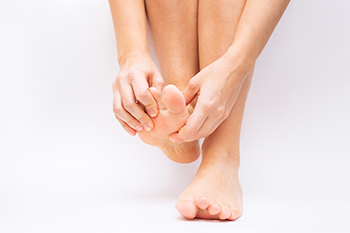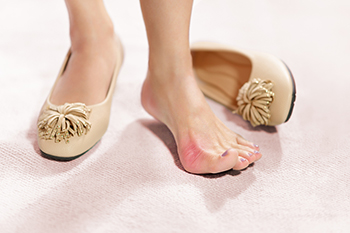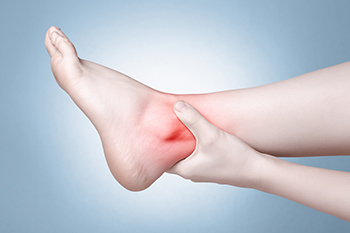November 2023
Causes of Second Toe Pain

Second toe pain, though often dismissed as a minor inconvenience, can reveal underlying issues that demand attention. The causes of this discomfort are diverse and can range from mechanical factors to underlying health conditions. Ill-fitting footwear, particularly shoes that squeeze the toes or have inadequate arch support, can contribute to pain in the second toe. Structural abnormalities, such as hammertoe or a longer second toe, may also be culprits. Injuries, whether acute or from repetitive stress, can lead to pain and inflammation. Arthritis affecting the joints in the toe, or conditions like Morton's neuroma, wherein a nerve becomes irritated, can contribute to discomfort as well. Understanding the multifaceted nature of second toe pain is important for identifying the root cause and seeking appropriate medical care. If you are experiencing pain in your second toe, it is suggested that you schedule an appointment with a podiatrist who can determine the cause and offer appropriate treatment options.
Toe pain can disrupt your daily activities. If you have any concerns, contact one of our podiatrists of Piedmont Podiatry Associates. Our doctors can provide the care you need to keep you pain-free and on your feet.
What Causes Toe Pain?
Most severe toe pain is caused due to a sports injury, trauma from dropping something heavy on the toe, or bumping into something rigid. Other problems can develop over time for various reasons.
Toe pain can be caused by one or more ailments. The most common include:
- Trauma
- Sports injury
- Wearing shoes that are too tight
- Arthritis
- Gout
- Corns and calluses
- Hammertoe
- Bunions
- Blisters
- Ingrown toenails
- Sprains
- Fractures (broken bones)
- Dislocations
When to See a Podiatrist
- Severe pain
- Persistent pain that lasts more than a week
- Signs of infection
- Continued swelling
- Pain that prevents walking
Diagnosis
In many cases the cause of toe pain is obvious, but in others, a podiatrist may want to use more advanced methods to determine the problem. These can range from simple visual inspections and sensation tests to X-rays and MRI scans. Prior medical history, family medical history, and any recent physical traumatic events will all be taken into consideration for a proper diagnosis.
Treatment
Treatments for toe pain and injuries vary and may include shoe inserts, padding, taping, medicines, injections, and in some cases, surgery. If you believe that you have broken a toe, please see a podiatrist as soon as possible.
If you have any questions please feel free to contact one of our offices located in Greenville, and Easley, SC . We offer the newest diagnostic tools and technology to treat your foot and ankle needs.
Less Invasive Bunion Surgery

Foot surgery is typically advised when less invasive treatments fail, or if the foot condition's long-term prognosis is poor. Patients often worry about perceived risks such as infection, swelling, and pain, as well as extended recovery periods impacting work and activities. However, these concerns are mainly linked to outdated surgical methods. Modern foot surgery, particularly minimally invasive techniques, uses smaller incisions and less surgical time, reducing postoperative risks and shortening recovery. For instance, bunion surgery has evolved from traditional open methods requiring larger incisions to keyhole surgeries with minimal incisions. This approach lessens infection risks, pain, and speeds up recovery. If you have a bunion or another foot condition that is not improving, it is suggested that you make an appointment with a podiatrist to see if you can benefit from minimally invasive foot surgery.
If you are suffering from bunions, contact one of our podiatrists of Piedmont Podiatry Associates. Our doctors can provide the care you need to keep you pain-free and on your feet.
What Is a Bunion?
A bunion is formed of swollen tissue or an enlargement of boney growth, usually located at the base joint of the toe that connects to the foot. The swelling occurs due to the bones in the big toe shifting inward, which impacts the other toes of the foot. This causes the area around the base of the big toe to become inflamed and painful.
Why Do Bunions Form?
Genetics – Susceptibility to bunions are often hereditary
Stress on the feet – Poorly fitted and uncomfortable footwear that places stress on feet, such as heels, can worsen existing bunions
How Are Bunions Diagnosed?
Doctors often perform two tests – blood tests and x-rays – when trying to diagnose bunions, especially in the early stages of development. Blood tests help determine if the foot pain is being caused by something else, such as arthritis, while x-rays provide a clear picture of your bone structure to your doctor.
How Are Bunions Treated?
- Refrain from wearing heels or similar shoes that cause discomfort
- Select wider shoes that can provide more comfort and reduce pain
- Anti-inflammatory and pain management drugs
- Orthotics or foot inserts
- Surgery
If you have any questions, please feel free to contact one of our offices located in Greenville, and Easley, SC . We offer the newest diagnostic and treatment technologies for all your foot care needs.
Understanding the Definition and Applications of MLS Laser Therapy

MLS, or Multiwave Locked System laser therapy, is an advanced and non-invasive medical technique that utilizes laser light to stimulate the body's natural healing processes. The therapy involves the use of dual wavelengths of light to penetrate tissues, reducing pain and inflammation while accelerating the healing of damaged cells. MLS laser therapy finds applications across various medical fields. It is often employed to address chronic and acute musculoskeletal conditions, such as arthritis, tendonitis, and sports-related injuries. The therapy works by improving blood flow to the affected area and promoting the production of endorphins, the body's natural painkillers. This leads to reduced pain, increased mobility, and enhanced tissue repair. In addition to pain management, MLS laser therapy is utilized in wound healing, post-operative recovery, and foot conditions. Its non-invasive nature and minimal side effects make it a valuable option for those seeking relief from various medical conditions. Understanding the definition and applications of MLS laser therapy sheds light on its significance in modern healthcare, offering an alternative approach to pain relief and healing. If you are interested in learning more about MLS laser therapy to treat your foot condition, it is suggested that you consult a podiatrist who can determine if this treatment method is right for you.
MLS Laser Therapy is a successful alternative for treating any pain you may be experiencing related to certain podiatric conditions. If you are interested in MLS Laser Therapy, consult with one of our podiatrists from Piedmont Podiatry Associates. Our doctors will assess your condition and provide you with quality foot and ankle treatment.
MLS Laser Therapy
Multiwave Locked System (MLS) Laser Therapy is a patented, FDA-cleared technology that helps relieve pain and inflammation from a number of podiatric conditions, including:
- Heel Pain
- Plantar Fasciitis
- Sports Injuries
- Wounds
- Achilles Tendonitis
- Arthritis
- Neuropathy
- Neuromas
MLS Laser Therapy is an ideal alternative to surgery and prescription medication, as it has no negative side effects and encourages accelerated healing. Among its many clinical benefits, MLS Laser Therapy also:
- Reduces swelling due to bruising or inflammation
- Blocks pain
- Reduces formation of scar tissue
- Improves nerve function
If you have any questions, please feel free to contact one of our offices located in Greenville, and Easley, SC . We offer the newest diagnostic and treatment technologies for all your foot care needs.
Infections and Ankle Pain

An infection in the ankle can lead to swelling and discomfort. One common type of skin infection on the ankle is cellulitis. People with diabetes are particularly susceptible to foot and ankle infections, making regular inspections for bruises, cuts, and scrapes crucial. When someone with diabetes leaves a foot or leg infection untreated, it can progress to gangrene. Gangrene is a serious condition that causes tissues to die, possibly resulting in a severe infection or reduced blood supply. Treatment for ankle infections varies depending on their type and severity. In cases of bacterial infections, a podiatrist will prescribe antibiotics to combat the infection. However, if the infection has advanced to gangrene, surgical intervention may be necessary to remove the damaged tissue and prevent further complications. Early detection and appropriate treatment are essential in managing these infections. If you have ankle pain and a brewing infection in this area, it is strongly suggested that you see a podiatrist as quickly as possible for a proper diagnosis and immediate treatment.
Ankle pain can have many different causes and the pain may potentially be serious. If you have ankle pain, consult with one of our podiatrists from Piedmont Podiatry Associates. Our doctors will assess your condition and provide you with quality foot and ankle treatment.
Ankle pain is any condition that causes pain in the ankle. Due to the fact that the ankle consists of tendons, muscles, bones, and ligaments, ankle pain can come from a number of different conditions.
Causes
The most common causes of ankle pain include:
- Types of arthritis (rheumatoid, osteoarthritis, and gout)
- Ankle sprains
- Broken ankles
- Achilles tendinitis
- Achilles tendon rupture
- Stress fractures
- Tarsal tunnel syndrome
- Plantar fasciitis
Symptoms
Symptoms of ankle injury vary based upon the condition. Pain may include general pain and discomfort, swelling, aching, redness, bruising, burning or stabbing sensations, and/or loss of sensation.
Diagnosis
Due to the wide variety of potential causes of ankle pain, podiatrists will utilize a number of different methods to properly diagnose ankle pain. This can include asking for personal and family medical histories and of any recent injuries. Further diagnosis may include sensation tests, a physical examination, and potentially x-rays or other imaging tests.
Treatment
Just as the range of causes varies widely, so do treatments. Some more common treatments are rest, ice packs, keeping pressure off the foot, orthotics and braces, medication for inflammation and pain, and surgery.
If you have any questions, please feel free to contact one of our offices located in Greenville, and Easley, SC . We offer the newest diagnostic and treatment technologies for all your foot care needs.





